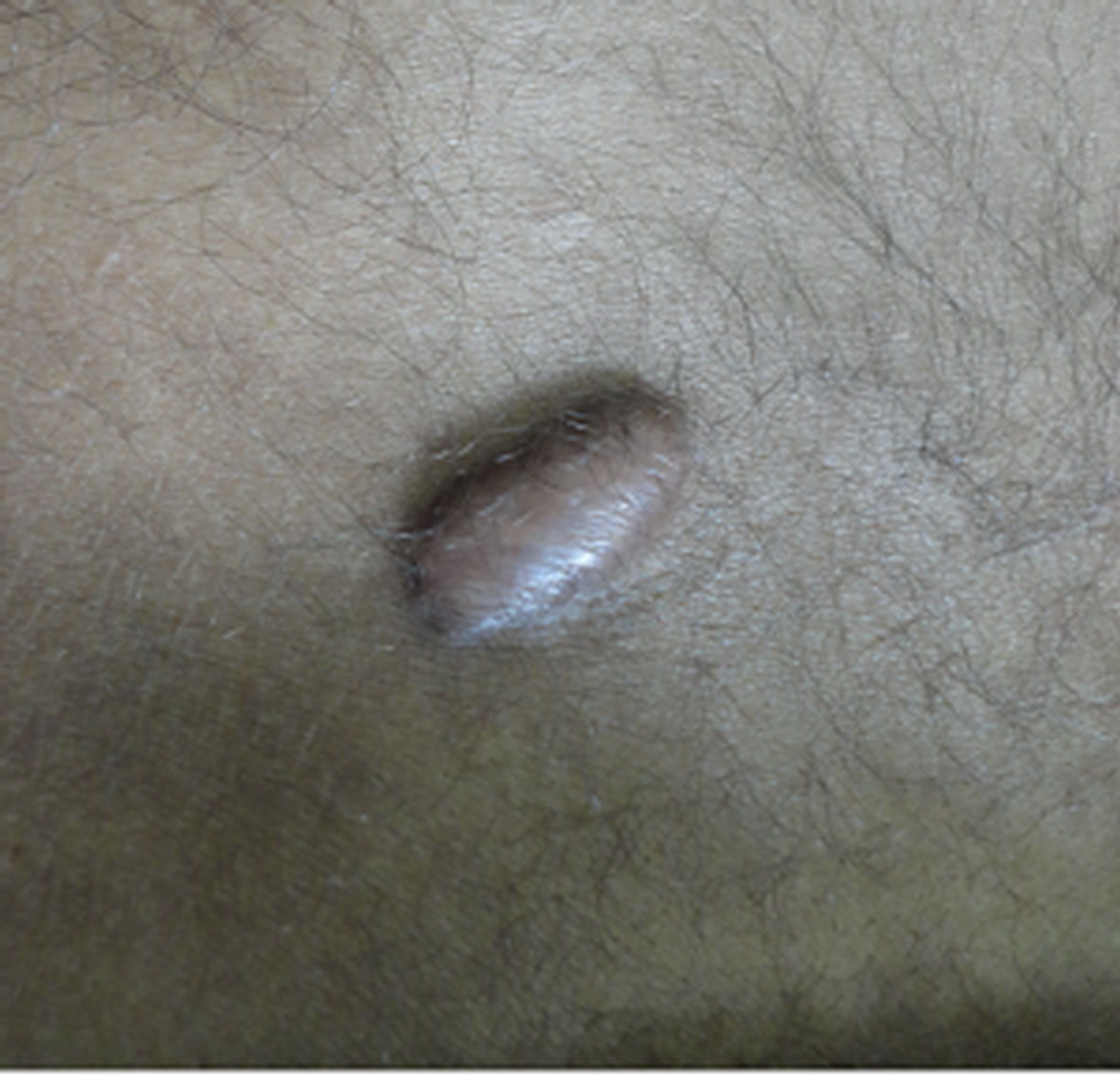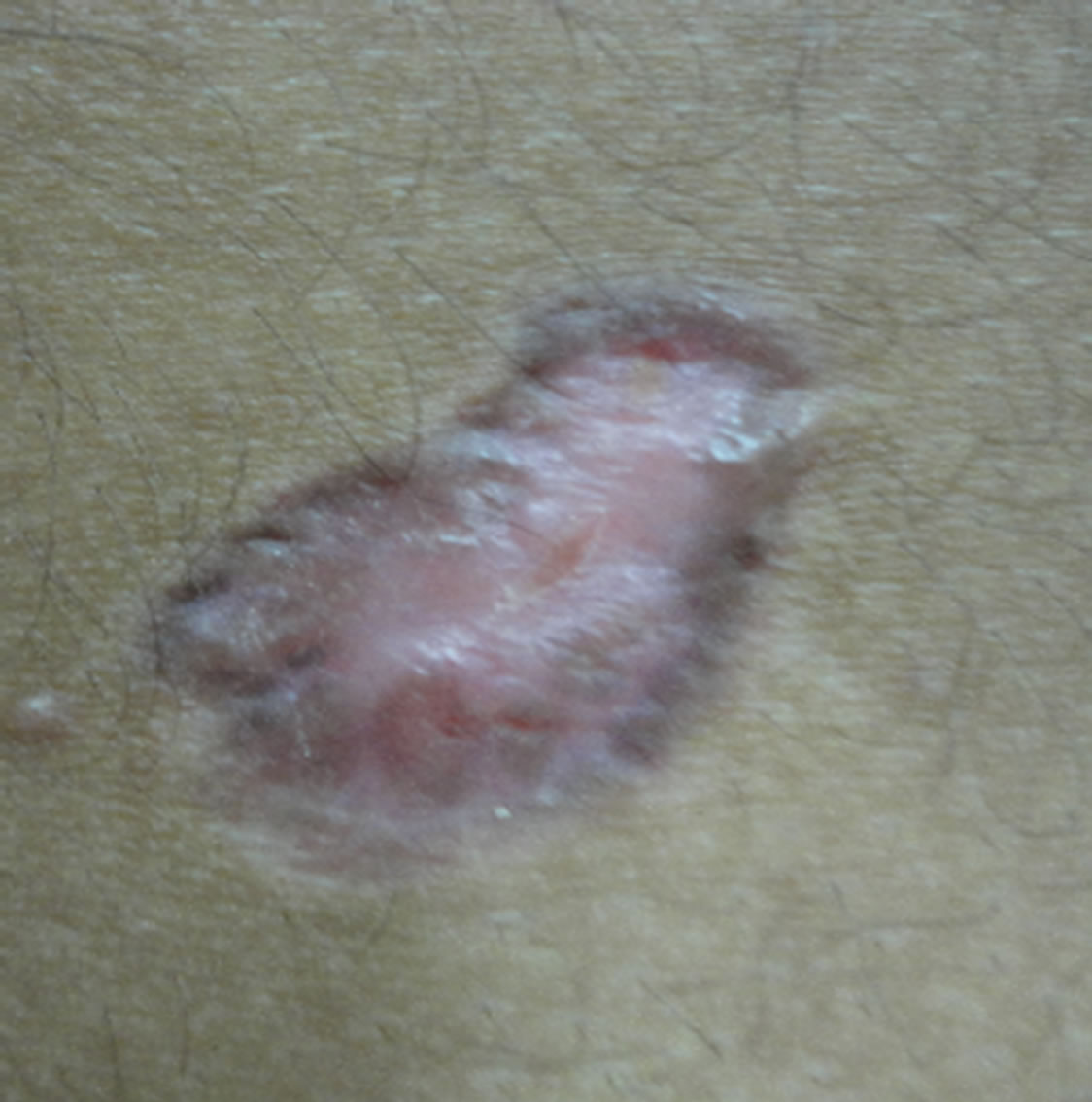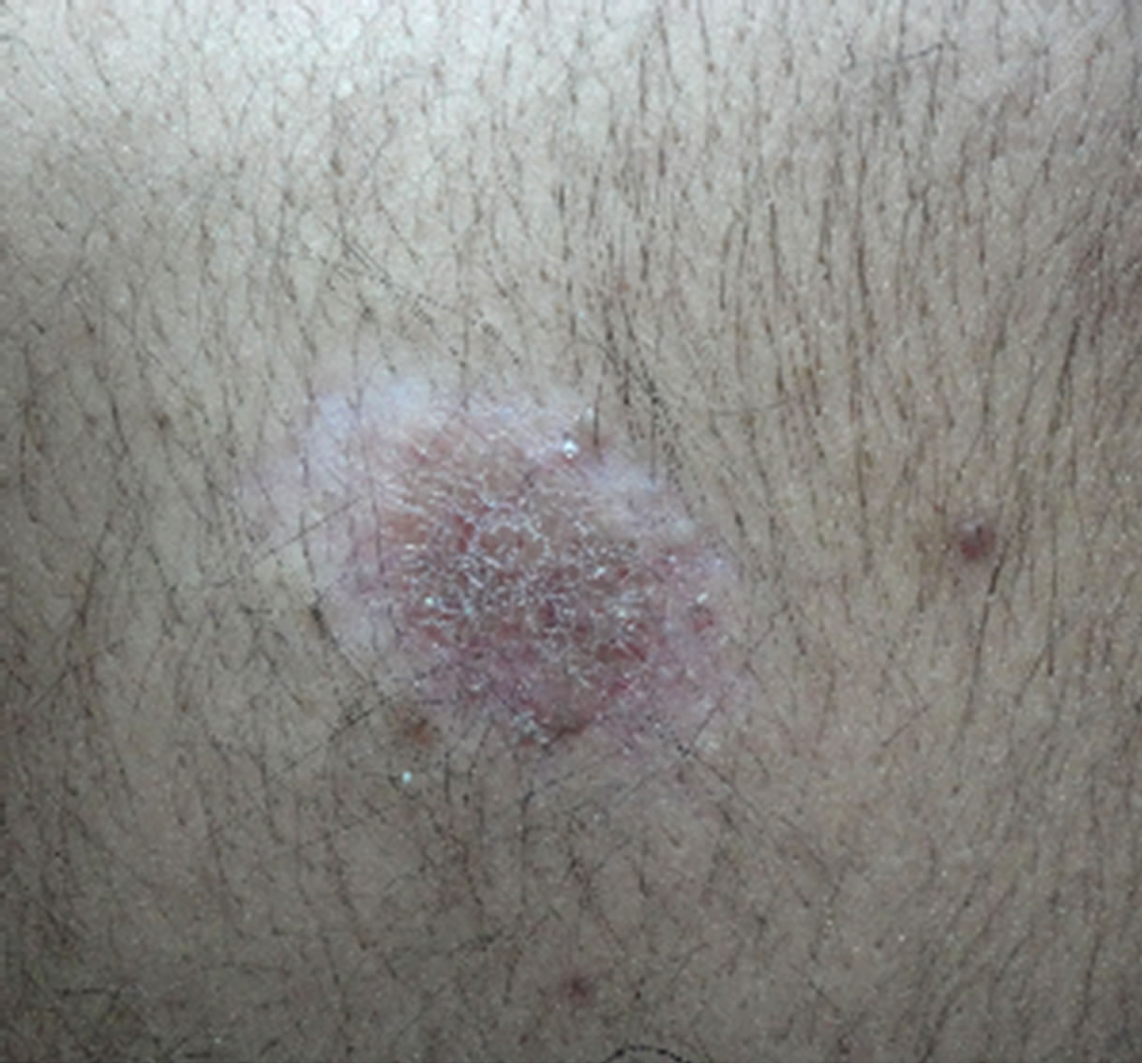Debulking of Keloid Combined with Intralesional Injection of 5-Flurouracil and Triamcinolone versus Intralesional Injection of 5-Flurouracil and Triamcinolone ()
1. Introduction
Keloid is a benign proliferative lesion of the dermal connective tissue that usually results from an excessive tissue response to cutaneous trauma in genetically predisposed individuals, which usually does not resolve spontaneously [1] [2] . Keloid occurs in all races with a predominance of the disease in African in which it occurs more in pigmented tribes. In a randomized study, 5.4% of black patients give a history of keloid [2] [3] .
The disease appears to run in families, but the mode of inheritance is not clear and both autosomal dominant and autosomal recessive patterns have been suggested. Women are more often affected than men [3] [4] .
The presternal area, the back and the posterior neck are the most susceptible regions of the body and they form severe keloids. The ears, deltoid areas, anterior chest, beard areas of the face and rest of the neck are moderately susceptible while the abdominal skin, forearm and rest of the face are mildly susceptible [1] . Keloids on palms and soles are unknown, and keloids on a very lax skin like upper eyelids, penis, scrotum and areola of the breast are very rare and unusual [4] [5] . Keloids usually arise secondary to wounds or injuries but they may arise without an apparent injury when they termed spontaneous keloids [6] . The onset is gradual, and pruritus as a symptom is invariable and often associated with pain and hyperesthesia [7] . There is no routinely effective therapy for all keloids, but a variety of treatment methods exist [5] -[7] . The variety of treatment methods suggests that none is very satisfactory as the lesion is notoriously recurrent. These include surgical excision, intralesional steroid injection, cryotherapy, laser therapy, use of ionizing radiation, mechanical compression dressing, silicone sheet applications, ultrasound and heat therapy, intralesional interferon injection, or combination of techniques, and many others (Table 1) [8] -[12] .
The most frequent treatment of keloid is surgical excision or shaving of the lesion with the skin surface followed by intralesional injection of steroid with a variable success rate [12] -[14] .
When surgery is indicated, it is usually used in combinations with other methods of treatment. Triamcinolone acetonide is the steroid of choice for intralesional treatment of established keloids to cause its atrophy or post-operatively to prevent recurrence of excised keloid [15] . It is a potent steroid with powerful anti-inflammatory effect that commercially prepared in a moderately insoluble form, so that its action is localized within the area of injection [15] [16] . Corticosteroids are felt to act both by decreasing collagen synthesis and by increasing collagen degradation by decreasing the level of collagenase inhibitors such as a2-macroglobulin and a1-antitrypsin [16] [17] .
Untreated keloid nodules contain three times the normal amount of DNA lesions treated with triamcinolone

Table 1. Showing the different modalities of therapy.
exhibit 35% reduction in its DNA; suggesting that it decreases the cellularity of these lesions [18] . This has been proven in a recent study done in vitro on keloid fibroblast. Triamcinolone acetonide has been shown to decrease both cellular proliferation and collagen production by dermal fibroblasts [14] [19] .
Five flurouracil (5-FU) alone is effective in the treatment of keloids, and there is enough evidence that a combination of 5-FU and triamcinolone is superior over triamcinolone alone. There is also evidence that a combination of triamcinolone and 5-FU results in less skin atrophy and telangiectasia than triamcinolone alone pain, hyperpigmentation, and that tissue sloughing are the main adverse effects of 5-FU therapy for keloids [17] -[29] .
By present work, we are assessing debulking of keloid without suturing combined by intralesional injection of 5FU and triamcinolone to be compared with intralesional injection of 5FU and triamcinolone alone.
2. Patients and Methods
This single blinded comparative therapeutic outpatient based study was done at the Department of Dermatology, Baghdad Teaching Hospital during the period from February 2011 to February 2013. A total of 23 patients with 52 lesions satisfied the selection criteria and they were 26 (50.0%) lesions found in males and 26 (50.0%) lesions found in females. This study consists of two groups:
Group A: (n = 26 lesions) patients were given1ml of 5-FU (50 mg with up to a maximum of 2 ml being used per dose) and 0.5 ml triamcinolone acetonide (20 mg) and 1ml 2% xylocain as combination to infiltrate the keloid without removal.
Group B: (n = 26 lesions) Debulking was carried out first and then injection of 5-FU and triamcinolone acetonide and 2% xylocain in dose similar to Group A. Patients with single lesion was treated by either Group A or Group B, while patients with multiple keloidal lesions were treated by more than one group in the same patient.
The nature and target of this study were explained for each patient and formal consent was taken for each patient before starting the therapy, after full explanation about the nature of the disease, course, the procedure of treatment, follow up, prognosis and the need for pre and post treatment photographs by Sony-Digital, high sensitivity, 16.1 megapixels, 5× optical zoom camera in the same place with fixed illumination and distance. Also, ethical approval was given by the scientific committee of the Scientific Council of Dermatology and Venereology-Arab Board for Medical Specializations. Statistical analysis was carried out using T test and Chi square.
Inclusion criteria include: Extension of the growth beyond the boundaries of the original lesion or injury, at least 1 year duration keloid, the last modality of treatment used at least 6 months ago with either no response or recurrence. Exclusion criteria include: pregnant women or if want to be pregnant, lactating women, hepatic dysfunction, renal dysfunction, active infectious disease and blood dyscrasia.
Complete blood cells count (CBC), liver function, renal function and blood sugar were performed prior to initiation of therapy. CBC was repeated every week for the first 2 weeks and then once every 4 weeks, while blood chemistry was repeated once every 4 weeks during treatment.
2.1. Technique of Injection
Seventy percent ethanol was used as topical antiseptic agent before injection. Disposable syringe with 27 gauge needle syringe was inserted into the substance of keloid and the solution pushed with adequate pressure till minimal blanching was seen. This was repeated at multiple sites on the keloid, while in case of debulking under local anesthesia we use the scalpel to remove the keloid with the surface of normal skin with intralesional injection before and immediately after removal of keloid and few millimeters surrounding normal skin was injected without suturing. The 5-Flouracial vial manufactured by EBEWE Pharma Ges.m.b.H. Nfg.KG Company (AUSTRIA), while the triamcinolone acetonide vial 40 mg, manufactured by Bristol-Myers Squibb Anagni Company (FR) Italy.
2.2. Follow up
Patients were seen first after two weeks and without injection and then monthly injections were carried with maximum of 6 sessions total injection after that scoring for the response was carried out and to report any local or systemic side effects. Followed up was carried out for 5 months to watch any recurrence of keloid.
2.3. Evaluation of the Lesion
The lesions were evaluated according to the score system employ in 5 criteria: Redness, elevation, hardness, itching, tenderness and pain with scoring from 0 - 3 (Table 2).

Table 2. The scoring criteria [4] .
The evaluation of response was graded as follows:
I. No response.
II. Minimal response:
a) Change of one score in no more than 3 criteria.
b) Change of one score in no more than 2 criteria provided that one or more criterion was ranking 0 score before embarking upon our treatment.
III. Moderate response: improvement more than minimal and less than complete.
IV. Complete: change of the score into 0 in all criteria.
3. Results
Twenty three patients with 52 lesions satisfied the selection criteria. The mean of score before treatment was (9.23) and after treatment was (5.27) (P < 0.001) for Group A. The mean of score before treatment was (9.46) and after treatment was (5.23) (P < 0.001) for Group B. The difference was statistically significant for both groups. When the two groups compared with each other it was found that the response was statistically not significant (P value = 0.104) (Figure 1).
Moderate response was observed in 38.5% of patients in Group A and 23.1% of patients in Group B. Minimal response was observed in 53.8% of patients in Group A and 76.9% of patients in Group B. No response observed in 7.7% of patients in Group A and no one in Group B showed no response (Table 3) (Figure 2).
There was no significant statistical difference in the recurrence rate in both treatment modalities (p value = 0.174). Regarding the side effects in both groups were shown in Table 4.
Regarding local side effects, hyperpigmentation was observed in 30.8% of patients in Group A and 46.2% in Group B. Atrophy was observed in 11.5% of patients in Group A and 19.2% in Group B. Ulceration was observed in 7.7% of patients in Group A and 23.1% in Group B. No statistical difference between both groups was presented. Also, there are no systemic adverse effects were noticed during study period.
4. Discussion
Five-Flurouracil (5-FU) is still a widely used anticancer drug. Since 1957, it has played an important role in the treatment of colon cancer and is used for patients with breast and other cancers, like those of the head and neck [1] .
The limited success of one technique has given rise to numerous treatment protocols for therapy of keloid. These include surgical excision, intralesional steroid injection, cryotherapy, laser therapy, use of ionizing radiation, mechanical compression dressing, silicone sheet applications, ultrasound and heat therapy, intralesional in-
 (a)
(a) (b)
(b)
Figure 1. A male patient with keloid on right shoulder before and after debulking with intralesional injection of 5-FU + TAC. (a) Before debulking; (b) 1 year after debulking.
 (a)
(a) (b)
(b)
Figure 2. A male patient with keloid scar on lower back before and after intralesional injection of 5-FU + TAC without debulking. (a) Before intralesional injection; (b) 1 year after injection.

Table 3. The response to treatment.
P value = 0.12.

Table 4. Showing the recurrence rate of both groups.
P value by chi square = 0.1743.
terferon injection, or combination of techniques, and many others [2] -[5] .
The present work showed that both modalities of therapy were effective in treatment of keloid but when compared with each other, there was no statistical difference; although the moderate response was better in the non-debulking compared with debulking group.
Recurrence rates of keloids after excision range between 45% and 100% [6] . Given this high recurrence rate, surgical intervention without adjuvant therapy should be considered with caution. Excision may frequently result in a longer scar than the original keloid, and recurrence in this new area of trauma may lead to an even larger keloid [7] [8] .
Since the mid-1960s intralesional steroid injections have gained popularity as one of the most common approaches to attenuate hypertrophic scar and keloid formation [9] . Most of the known effects of corticosteroids are thought to result primarily from its suppressive effects on the inflammatory process in the wound [10] , and secondarily from diminished collagen and glycosaminoglycan synthesis, inhibition of fibroblast growth [11] and enhanced collagen and fibroblast degeneration [12] .
The overall response of treated keloid to different treatment modalities used in the present work showed that no lesion was completely cured, furthermore the combination therapy of 5-FU + TAC with debulking was found to achieve good response rate in comparison with other drug modalities.
Regarding the recurrence rate in both groups was almost comparable. In keloid surgery especially when the lesion excised and sutured, the relapsed keloid usually bigger in size than before surgery [8] , while the present study ,the relapse lesion were either same size or could be smaller than before surgery.
The side effects in both groups were comparable like hyperpigmentation, atrophy and ulceration, without difference in the side effects in both groups. No systemic side effects were reported in both groups over 6 months follow up period and confirmed by laboratory test.
5. Conclusion
In conclusion, debulking with 5-FU + TAC injection and intralesional injection with 5-FU + TAC alone were effective treatment for keloid but there was no much difference between them.
Disclosure
This study is an independent study and not funded by any drug company.
NOTES

*Corresponding author.